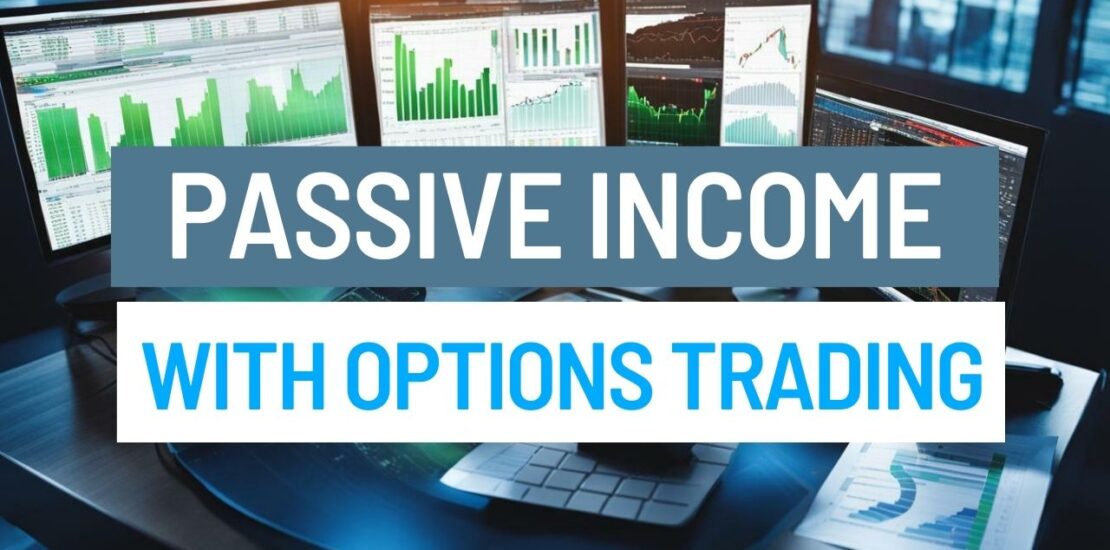- November 2, 2023
- Posted by: Shane Daly
- Categories: Options Trading, Trading Article

Passive income through options trading can be achieved by selling options rather than buying them. Buying options can lead to losses, as the trader needs the stock to move significantly in order to make a profit. On the other hand, selling options allow traders to collect premiums and profit even if the stock doesn’t move in their favor.

There are several strategies for selling options, including covered calls, cash-secured puts, protective collars, call credit spreads, put credit spreads, iron condors, and iron butterflies. Each strategy has its own risk profile and potential for generating income.
Other strategies for generating passive income in the stock market include value investing, dividend investing, and using LEAP options, and iron condors.
Key Takeaways:
- Passive income can be generated through options trading by selling options instead of buying them.
- Selling options allow traders to collect premiums and profit even if the stock doesn’t move in their favor.
- Strategies for selling options include covered calls, cash-secured puts, protective collars, call credit spreads, put credit spreads, iron condors, and iron butterflies.
- Other strategies for generating passive income in the stock market include value investing, dividend investing, and using LEAP options, iron condors, and cryptocurrency bots.
- Choosing the right strategy depends on individual risk profile and income goals.
Selling Options for Passive Income
By selling options, you can collect premiums and generate passive income, regardless of whether the stock moves in your favor or not. This approach to options trading offers several advantages over buying options. When you buy options, you need the stock to move significantly in order to make a profit.
As an options seller, you can profit from the passage of time (time decay) and changes in market volatility.
When you sell an option, you receive an upfront payment or premium from the buyer. This premium is yours to keep, regardless of the outcome of the trade. Even if the stock price remains unchanged or moves against you, you can still make a profit by keeping the premium.
Look at this example:
Imagine you own 100 shares of XYZ Corporation, currently trading at $50 per share. You believe that the stock is probably not going to rise significantly in the near term and want to generate income from your investment.
- Choose an Option to Sell: You decide to sell a covered call option on your XYZ shares. A covered call involves selling a call option while simultaneously holding the underlying stock. Let’s say you choose to sell one XYZ call option with a strike price of $55, which expires in one month.
- Determine the Premium: You check the options market and see that the premium for the XYZ $55 call option is $2 per share. Since one options contract represents 100 shares, the total premium you can collect is $200 ($2 per share x 100 shares).
- Execute the Trade: You place a sell-to-open order for the XYZ $55 call option. This means you’re selling the call option to another investor who believes that XYZ will rise above $55 before the expiration date. In exchange for taking on this obligation, you collect the $200 premium.
- Outcome Scenarios:
- If XYZ’s stock price remains below $55 by the expiration date:
- You keep the $200 premium.
- You continue to own your 100 shares of XYZ, which you can sell or hold as you wish.
- If XYZ’s stock price rises above $55 by the expiration date:
- The call option you sold may be exercised by the buyer, who will buy your 100 shares at the strike price of $55 per share.
- You keep the $200 premium.
- You sell your shares at $55, even if the market price is higher, which means you will miss out on any gains above $55.
- If XYZ’s stock price remains below $55 by the expiration date:

Selling options can be a profitable approach to generating passive income. With the ability to collect premiums and a variety of strategies you can use, you can take advantage of different market conditions and profit regardless of how the stock moves.
Whether you choose covered calls, cash-secured puts, or other options selling strategies, it’s essential to understand the risks involved and develop a disciplined approach to managing your trades.
Strategies for Selling Options
Selling options can be a great approach for generating passive income as it allows you to collect premiums(that you can keep) and make profits, regardless of whether the stock moves in your favor or not.
Covered Calls
We talked about this one earlier. A covered call strategy involves selling a call option on a stock you currently own. By selling the call option, you receive a premium upfront. If the stock remains below the strike price of the option at expiration, the option will expire worthless, and you get to keep the premium.
If the stock price rises above the strike price, you may lose your stock if the buyer of the options exercises their right at the strike price.
This strategy is ideal for generating income from stocks you already own while potentially earning additional profits if the stock doesn’t rise significantly.
Cash-Secured Puts
In a cash-secured put strategy, you sell a put option on a stock you would like to own. By selling the put option, you collect a premium and potentially obligate yourself to buy the stock at the strike price if it falls below that level.
If the stock price remains above the strike price at expiration, the put option will expire worthless, and you keep the premium. This strategy allows you to generate income while potentially acquiring the stock at a lower price if it declines.
Protective Collars
A protective collar strategy involves selling a call option against a stock you own and using the premium received to purchase a put option to protect against a potential decline in the stock’s value. This strategy is also used in hedging strategies.
This strategy limits your upside potential but provides protection in case the stock price drops. With a protective collar, you can collect premiums while safeguarding your stock against market volatility.
Credit Spreads
Credit spreads involve selling an option with a higher strike price and buying an option with a lower strike price, both with the same expiration date. By selling an option with a higher strike price, you collect a premium, and by buying an option with a lower strike price, you limit your potential loss.
The difference between the premiums received and paid represents your potential profit. Credit spreads are a popular strategy for generating income by focusing on the range-bound movement of a stock.
| Strategy | Risk Profile | Income Potential |
|---|---|---|
| Covered Calls | Limited Upside, Potential for Stock Loss | Premium Received from Call Option |
| Cash-Secured Puts | Stock Ownership, Potential for Loss | Premium Received from Put Option |
| Protective Collars | Limited Upside, Downside Protection | Premiums Received from Call and Put Options |
| Credit Spreads | Limited Profit, Limited Loss | Net Premium Received |
Credit spreads is the favorite options strategy here at Netpicks.
By using these strategies, you can diversify your options selling approach and potentially increase your passive income potential. Remember that each strategy has its own risk profile and income potential.
It’s essential to thoroughly understand each strategy, assess your risk tolerance, and consider market conditions before implementing them in your trading plan.

There are other strategies like value investing, dividend investing, and utilizing LEAP options, iron condors, and cryptocurrency bots that can help you build passive income. These strategies offer different approaches to generating income in the stock market, allowing you to diversify your portfolio and increase your potential for long-term financial success.
Value Investing
This involves identifying undervalued stocks and investing in them with the expectation that their value will increase over time. By focusing on the fundamentals of a company, such as its earnings, assets, and growth potential, value investors aim to buy stocks at a discounted price and sell them for a profit when the market recognizes their true value.
This strategy requires patience and a strong understanding of the stock market, but it can be highly rewarding for those who are willing to do their research and base their decisions on facts and not hope.
Dividend Investing
Another popular strategy for generating passive income is dividend investing. Dividend stocks are companies that distribute a portion of their profits to shareholders on a regular basis. By investing in dividend stocks, you can earn a steady stream of income without having to sell your shares.
This strategy is particularly appealing for income-focused investors who are looking to build a portfolio that generates consistent cash flow.
LEAP options, iron condors, and cryptocurrency bots
LEAP options, or Long-term Equity Anticipation Securities, are options contracts with longer expiration dates. These contracts allow investors to benefit from price movements in the underlying asset over an extended period of time. LEAP options can be an effective tool for generating passive income as they provide flexibility and the potential for higher returns compared to short-term options.
Iron condors are options strategies that involve selling both a call spread and a put spread with the same expiration date. This strategy allows traders to generate income through the collection of premiums while limiting their potential losses. By selecting strike prices outside of the expected range of the underlying asset, iron condors can be used to generate consistent returns in a sideways market.
As with any investment strategy, it’s important to thoroughly research and understand the risks involved before implementing them in your portfolio. Each strategy has its own unique characteristics and requires careful consideration to ensure it aligns with your financial goals and risk tolerance.
Leveraging Options for Your Financial Future
To effectively leverage options for passive income, it’s essential to understand and utilize various strategies.
- Covered calls
- Cash-secured puts
- Protective collars
- Call credit spreads
- Put credit spreads
- Iron condors
- Iron butterflies
These are popular strategies that can be used to generate income in different market conditions. Each strategy has its own risk profile, income-generating potential, and suitability for different market scenarios. By diversifying your strategies, you can maximize your passive income potential and protect your portfolio against market fluctuations.
| Options Strategies | Risk Profile | Income-Generating Potential |
|---|---|---|
| Covered Calls | Low to moderate | Collect premiums |
| Cash-Secured Puts | Moderate | Collect premiums, buy the stock at a discount |
| Protective Collars | Low to moderate | Protect downside, collect premiums |
| Call Credit Spreads | Low to moderate | Collect premiums, limited risk |
| Put Credit Spreads | Low to moderate | Collect premiums, limited risk |
| Iron Condors | Moderate to high | Collect premiums, high risk-reward ratio |
| Iron Butterflies | Moderate to high | Collect premiums, limited risk |
By leveraging options trading and exploring various strategies, you can create a path to financial stability and success. It’s essential to educate yourself, seek guidance from experienced professionals, and develop a comprehensive plan that aligns with your financial goals. Remember, options trading involves risks, and it’s important to carefully assess and manage those risks to protect your capital and generate consistent passive income over time.
Conclusion
Passive income through options trading offers a great opportunity to control your financial future. By selling options instead of buying them, you can collect premiums and make income, even if the stock doesn’t move in your favor. This strategy provides a more reliable and consistent approach to generating passive income compared to buying options.
There are several strategies available for selling options, including covered calls, cash-secured puts, protective collars, call credit spreads, put credit spreads, iron condors, and iron butterflies. Each strategy has its own risk profile and income-generating potential, allowing you to tailor your approach based on your risk tolerance and financial goals.
Take the time to educate yourself on the various strategies and tools available, and consider seeking advice from experienced professionals or utilizing reliable resources to enhance your profitability.
FAQ
Q: Can options trading generate passive income?
A: Yes, options trading can generate passive income, especially through selling options rather than buying them.
Q: Why is selling options a better approach for passive income?
A: Selling options allows traders to collect premiums and profit even if the stock doesn’t move in their favor, making it a more profitable approach.
Q: What are some strategies for selling options?
A: Strategies for selling options include covered calls, cash-secured puts, protective collars, call credit spreads, put credit spreads, iron condors, and iron butterflies. Each strategy has its own risk profile and potential for generating income.
Q: Are there other strategies for passive income in the stock market?
A: Yes, other strategies for generating passive income in the stock market include value investing, dividend investing, and using LEAP options, iron condors.
Unlock the Secrets to Options Trading Success!
Discover the 6 game-changing secrets that have powered success for over 24 years. Dive into our exact trading blueprint, learn how to capitalize on volatile markets, and find out how to achieve returns of up to 120% on top-performing stocks like Amazon, Netflix, and Bank of America.
